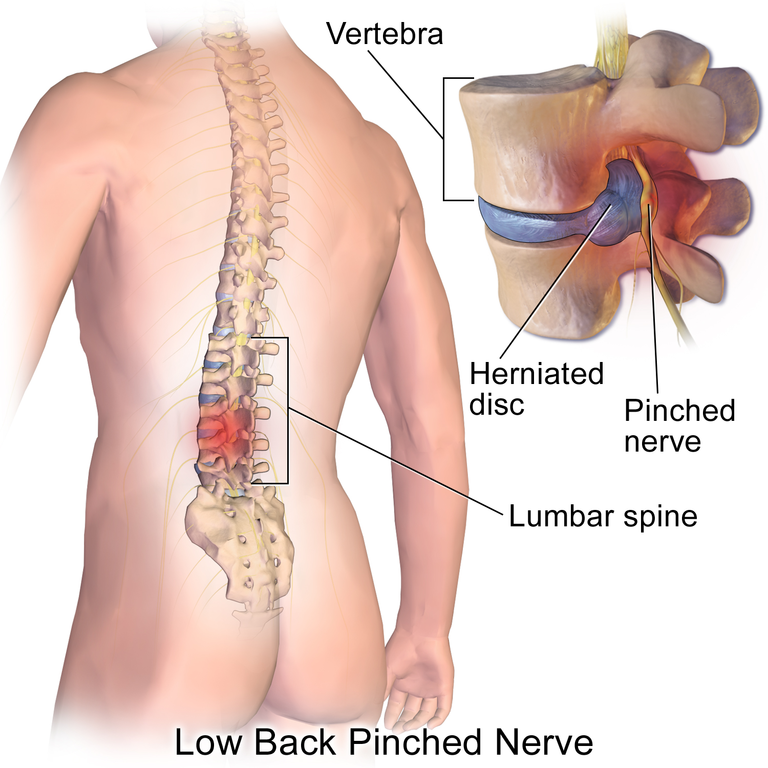What is Lumbar Radiculopathy?

Lumbar Radiculopathy, a pinched nerve, is a common condition affecting the lower back and legs. It is a condition where the nerves in your lower back get squeezed or irritated. These nerves act like messengers, sending signals to and from your legs. When they’re bothered, it can cause pain and discomfort in your lower back and legs
Radiculopathy vs. myelopathy
Radiculopathy and myelopathy are painful spine conditions with different causes and effects. Radiculopathy involves a pinched nerve root near the spine and usually heals over time without treatment. Myelopathy is compression of the spinal cord and can worsen if left untreated.
Radiculopathy vs. Sponylolysis
Spondylolysis is a wear and tear in the vertebrae connection, leading to degeneration of the discs it can lead to osteoathiritis. Radiculopathy, in contrast, is caused by compressed or irritated nerve roots and may or may not be present with degeneration.
Radiculopathy vs.Sciatica
Both radiculopathy and sciatica result from pinched nerves, radiculopathy of sciatic nerve is called sciatica. Therefore radiculopathy is the general term and sciatica is a specific name. Both Radiculopathy and scaiatica can cause pain in the back, buttocks, or legs, but sciatica specifically affects the sciatic nerve, resulting in pain along the lower back and down the legs below the knee.
What are the Causes and Symptoms of Lumbar Radiculopathy?

The main signs of Lumbar Radiculopathy are:
- Weakness: Your legs might feel weak, making it hard to move around.
- What are the Causes of Lumbar Radiculopathy?
- Lumbar Radiculopathy can happen due to a few reasons:
- Disc Bulge: Sometimes, a disc in your back bulges out and presses on the nerves.
- Narrow Space: The space where the nerves come out of your spine might get too narrow, putting pressure on them.
- Wear and Tear: Regular wear and tear on your back can cause problems with the discs, leading to nerve compression.
- Slipped Bone: In some cases, a bone in your spine may slip forward and pinch the nerves.
- Tingling or Numbness: You may experience a tingling or numb feeling in your legs or feet.
- Pain: You might feel pain traveling from your lower back down to your legs.
How is Lumbar Radiculopathy Diagnosed?
To find out if you have Lumbar Radiculopathy, your doctor will ask you about your symptoms and perform a physical exam. They might also use X-rays, MRI, or CT scans to look at your spine and nerves.
1. X-ray: X-rays are commonly used to show changes in the spinal cord’s alignment and detect any spinal fractures. However, they may not provide detailed images of soft tissues or nerves.
2. Computed Tomography (CT) Scan: A CT scan provides 3D images and more detailed views of the spine compared to X-rays. It helps identify issues like narrowing and abnormalities in the spinal canal and surrounding structures.
3. Magnetic Resonance Imaging (MRI): An MRI is effective in revealing soft tissue damage that may be causing nerve compression. It provides clear images of the spinal cord and detects any damage or abnormalities.
4. Electromyography (EMG): EMG is used to measure electrical impulses in muscles. This helps determine if the nerves are functioning properly, assisting healthcare providers in identifying whether symptoms result from spinal nerve root pressure or other conditions, such as nerve damage due to diabetes.
How To Treat Lumbar Radiculopathy?
The good news is that most people with Lumbar Radiculopathy can get better without surgery. Here are some ways to feel better:
Special Exercises: You can consult our expert physiotherapists and they will give you specific exercises to make your back and legs stronger and more flexible.
Heat or Cold Packs: Using heat or cold packs and gentle electrical therapy can ease the pain.
Medicine: Your doctor may prescribe medicine to reduce inflammation and relieve pain.
How Simply Align Rehab Physiotherapy and Chiropractic Can Help You With Lumbar Radiculopathy Recovery?
Our Physiotherapists and chiropractors can play a significant role in the treatment and management of Lumbar Radiculopathy. Our skilled physiotherapists and doctors can design a personalized treatment plan to address your specific needs. Here’s how our physiotherapy services can help with Lumbar Radiculopathy:

1. Pain Relief: Our Physiotherapy can employ various techniques and machines to provide pain relief, such as Tecar or Radiofrequency, shock wave, laser and spinal decompression table. These modalities can help reduce inflammation and soothe irritated nerves, providing relief from pain.
2. Manual Therapy: Hands-on techniques, including soft tissue massage, joint mobilization, and manipulation, can help alleviate muscle tension and restore proper spinal alignment. Manual therapy can relieve pressure on the affected nerve and improve overall mobility. Chiropractic adjustments also fall under manual therapy. Adjustments or manipulation of spine can help alleviate some radiculopathy.
3. Exercise Programs: Our physiotherapists and chiropractors design specific exercise programs to strengthen the core muscles, improve flexibility, and promote better posture. Strengthening the muscles around the lower back can provide better support to the spine and reduce the strain on the nerves.
4. Stretching Exercises: Stretching is essential to improve flexibility and reduce muscle tightness. Targeted stretches can help release tension in the lower back and legs, providing relief from pain and discomfort.
5. Postural Education: Our physiotherapists educate patients on proper posture while sitting, standing, and lifting to prevent further strain on the lower back. Correcting posture can alleviate pressure on the nerves and reduce the risk of exacerbating the condition.
6. Patient Education: Our physiotherapists educate patients about their condition, explaining how certain activities or postures can aggravate the symptoms. By understanding their condition better, patients can make informed choices and avoid activities that might worsen the condition.
7. Rehabilitation Program: After initial treatment, a structured rehabilitation program is essential to regain strength, flexibility, and function. Our expert physiotherapist will guide the patient through progressive exercises and monitor their progress.
8. Preventive Measures: Our Physiotherapists will provide guidance on lifestyle modifications, including maintaining an active lifestyle, adopting proper body mechanics, and managing weight. These measures can help prevent the recurrence of Lumbar Radiculopathy.
Overall, we at SimplyAlign Rehab aim to reduce pain, improve function, and enhance the patient’s quality of life. If you are experiencing symptoms of Lumbar Radiculopathy in Scarborough or Woodbridge, consider seeking help from our qualified physiotherapist for a comprehensive evaluation and personalized treatment plan.
Is it Possible to Prevent Lumbar Radiculopathy?
While some causes of lumbar radiculopathy are beyond your control, such as age-related degeneration, there are steps you can take to reduce your risk, especially when it comes to the most common cause – a herniated disc. Here are some preventive measures you can consider:
1. Lifting with Proper Technique: When lifting weights or heavy objects, ensure you use proper technique and avoid lifting more than your capabilities. Improper lifting can strain your back and increase the risk of a herniated disc.
2. Maintaining a Healthy Weight: Keeping a healthy weight can reduce stress on your spine and lower the likelihood of developing lumbar radiculopathy.
3. Avoiding Prolonged Sitting: Break up periods of prolonged sitting by taking short breaks to stretch and move around. Prolonged sitting can put pressure on your lower back and contribute to spine-related issues.
4. No Smoking: Avoid smoking, as it has been linked to increased disc degeneration. Quitting smoking can positively impact your spinal health.
5. Minimizing Twisting when Lifting: Be cautious and avoid twisting your body while lifting heavy objects, as this can strain your back and increase the risk of injury.
6. Regular Exercise: Engage in regular exercise, including activities that promote core strength and flexibility. Strengthening your core muscles can provide better support to your spine.
While it may not be possible to prevent all cases of lumbar radiculopathy, adopting these preventive measures can significantly reduce your risk and promote better spine health. Always consult with your healthcare provider or a qualified professional before starting any exercise program or making significant lifestyle changes. They can provide personalized guidance based on your individual health needs.
In the videos blow you can see spinal decompression therapy offered by both chiropractor and physiotherapist at both of our clinics in Vaughn Woodbridge and Toronto Scarborough location. You can also so how to avoid painful positions and spinal/core stability exercises recommended by us. (Remember you should always be assessed first.)
Are you looking for physiotherapy or a Chiropractor? If Yes, then visit Simply Align Rehab Physio in Scarborough/Toronto or Woodbridge/Vaughan or you can always call or text us for your Physiotherapy or Chiropractor needs in Toronto at (416) 438-3230 or For Physiotherapy or Chiropractor need in Vaughan (Woodbridge) at (905) 638-9840.
